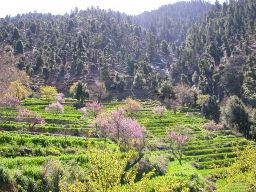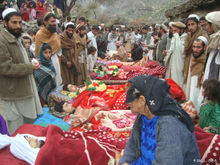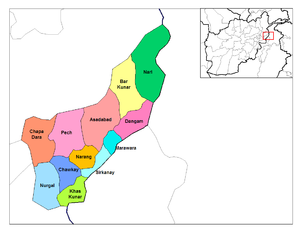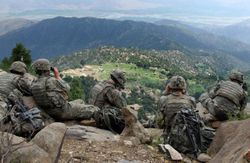Kunar Province
| Kunar (کونړ) | |
| Province | |
 |
|
| Country | |
|---|---|
| Capital | Asadabad |
| - coordinates | |
| Population | 413,008 [1] |
| Timezone | UTC+4:30 |
| Main language | Pashto |
 Map of Afghanistan with Kunar highlighted
|
|
Kunar (Pashto: کونړ) is one of the 34 provinces of Afghanistan, located in the northeastern part of the country. Its capital is Asadabad. It is one of the four "N2KL" provinces (Nangarhar Province, Nuristan Province, Kunar Province and Laghman Province). N2KL is the designation used by US and Coalition Forces in Afghanistan for the rugged and very violent region along the Afghanistan-Pakistan border opposite Pakistan's Federally Administered Tribal Areas and North-West Frontier Province. Kunar is the center of the N2KL region.
Contents |
Geography
Kunar province is located in the east of Afghanistan. It borders with Nangarhar Province to the south, Nuristan Province to the north, Laghman Province to the west and has a border with Pakistan in the east. The province covers an area of 4339 km2. Nearly nine tenths (86%) of the province is mountainous or semi mountainous terrain while one eighth (12%) of the area is made up of flat land.
Demographics & population
The total population of Kunar was estimated to be around 413,008 (CSO Afghanistan, 2006).[1] Pashtuns are in majority and make up 95% of the total population, followed by 5% Nuristanis. [2]
Around 96% of the population of Kunar lives in rural districts while 4% lives in urban areas.[1]
Military activity


During both the Soviet occupation, and the more recent conflicts involving U.S., Afghan and NATO forces, Kunar has been a favoured spot of insurgent groups. Its impenetrable terrain, cave networks and border with the semi-autonomous Pakistani North-West Frontier Province provides significant advantages for unconventional warfare and militant groups. The province is informally known as "Enemy Central" and "Indian Country" by American and western armed forces serving in Afghanistan. In 2009 approximately 60% of all insurgent incidents in the country occurred in Kunar.
Like many of the mountainous eastern provinces of Afghanistan, the groups involved in armed conflict vary greatly in strength and purpose. Native Taliban forces mingle with foreign Al-Qaeda fighters, while mujahadeen militias, such as Gulbuddin Hekmatyar's Hezb-e-Islami Gulbuddin, continue to operate as they did in the chaotic post-Soviet years. Another strong militia in the region is the Hezbi Islami faction of the late Mulavi Younas Khalis, who had his headquarters in neighbouring Nurestan Province.
Compounding the problems of the province is an extensive criminal trade in smuggled lumber, semi-precious stones and other natural resources. This criminal activity is often organized along tribal lines, and has led to intense deforestation in some areas. The rugged border area has many illegal and hidden crossing points making Kunar a high traffic route for arms smuggling, insurgent movement and smuggling activities.
The province, relatively small compared to others, has among the highest concentration of both US and Afghan security forces. Special Operations Forces operate extensively throughout the area.
Hunt for Bin Laden
Osama bin Laden has often been rumoured to be in the province, or close by. In an intensive military operation in summer 2005, called Operation Red Wing, American forces undertook a massive hunt for bin Laden and other senior Al-Qaeda leaders. While attempting to rescue four stranded Navy SEALS during the operation, 19 American Forces were killed when their CH-47 Chinook helicopter was shot down, representing the single biggest loss of American forces since their invasion of the country.
According to Pakistan's Interior Minister Rehman Malik, Osama bin Laden was most likely hiding in Kunar Province in the spring and summer of 2009: "According to our information Osama is in Afghanistan, probably Kunar, as most of the activities against Pakistan are being directed from Kunar.”[3] MUNN
Politics
Fazlullah Wahidi replaced Assadullah Wafa as the governor of Kunar Province on November 18, 2007.
Asadabad hosts both an American Provincial Reconstruction Team office and a UNAMA development office. Additionally, representatives of the United States Agency for International Development (USAID), US State and Agriculture Departments advise the local government. A US Army Agricultural Development Team was deployed to the province in late 2009.
Districts

| District | Capital | Population[1] | Area[4] | Notes |
|---|---|---|---|---|
| Asadabad | 29,177 | Is the Capital of Kunar Province, which includes Asadabad and adjacent towns, immediately surrounding the confluence of the Pech and Kunar Rivers. | ||
| Ghaziabad may be labeled as Bar Kunar | 23,663 | |||
| Bar Kunar | 20,716 | |||
| Chapa Dara | 28,681 | |||
| Dangam | 15,509 | |||
| Dara-I-Pech | 44,958 | Commonly known as the Pech District or Manogai District. | ||
| Khas Kunar | 31,950 | |||
| Marawara | 17,316 | |||
| Narang | 27,937 | |||
| Naray | 32,510 | |||
| Nurgol | 25,047 | |||
| Sawkai | 28,905 | |||
| Sirkani | 24,080 | |||
| Wata Pur | 28,778 | Is the West portion of the labeled Asadabad Section. | ||
| Shigal | 33,781 | is within the labeled Asadabad Section, East and North of Watapur. | ||
| Asmar | is between the labeled Asadabad and Dangam Sections, East and North of Shigal. |
Gallery
 |
 |
References
- ↑ 1.0 1.1 1.2 1.3 Kunar Provincial profile - MRRD [1]
- ↑ Afghanistan's Provinces – Kunar at NPS
- ↑ Christina Lamb, "Stop bombing us: Osama isn’t here, says Pakistan" The Sunday Times, July 12, 2009
- ↑ Afghanistan Geographic & Thematic Layers
|
|||||
|
|||||||